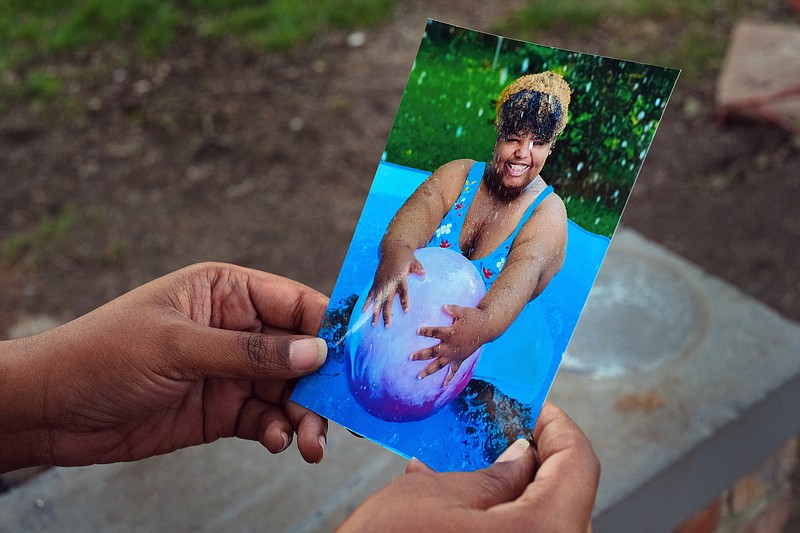What gets hard for Zapouria Lewis, in the sometimes overwhelming sadness, is knowing people will see her daughter only as a number.
One of 358 Hamilton County residents, one of 101 Black residents and the only resident between age 11 and 20 years old to die from COVID-19.
The number cannot describe who Nautika Lewis was - a 20-year-old who loved to sew, dance and go for walks. Someone who loved to sing, regardless of whether she hit the right note.
What also is hard for Lewis is knowing about people who do not take COVID-19 seriously, who do not follow guidelines about wearing masks or gathering in groups. The failures of some in the county to follow such guidance pushed infection rates, hospitalizations and deaths to record levels in Hamilton County in November and December.
It also puts people like Nautika at increased risk.
As a child, Lewis's daughter was diagnosed with Prader-Willi syndrome and, later, bipolar disorder, she said. Like the hundreds of thousands of people with intellectual or developmental disabilities may, she struggled to understand the risk of the pandemic, why she had to wear a mask and why she had to stay distant from friends.
"If people took it more seriously, my baby would still be here," Lewis said.
Experts said people with intellectual or developmental disabilities have been overlooked or misunderstood in health care, even before the pandemic. Many with these kinds of disabilities have underlying health issues, putting them at higher risk of severe or deadly cases if infected.
But there are holes in the understanding of how the virus affects such patients. Dr. Margaret Turk, professor of physical medicine and rehabilitation at the State University of New York's Upstate Medical University, authored several of the few existing studies published on the possible effects of the virus on people with intellectual or developmental disabilities. One study of residential group homes in New York found case rates four times higher and death rates twice as high in the homes than the rest of the state.
But the best available data misses large sections of people with intellectual or developmental disabilities, specifically those living with family members, Turk said.
"Nobody is required to report, and there's no standardization of what is required reporting," she said. "So while each state probably reports the number of cases and the number of deaths, not every state reports different populations or different groups."
The vulnerability of those who may struggle to understand the pandemic requires communities to better control the spread and keep people safe, experts said.
Nautika was well-known around the neighborhood, Lewis said. Everyone was considered a cousin or an uncle. She worked at Chatt Smoke House and liked to volunteer.
There were hard days because of Nautika's behavioral issues. She was old enough to be considered an adult and wanted to be treated like one, Lewis said.
When COVID-19 hit Chattanooga, some of the programs Nautika worked with were no longer available, Lewis said. The safest place for her daughter was at home, isolating like the rest of the family. Nautika resisted.
"We would look at the news and we would talk about the virus but it didn't connect with her. I know it didn't," Lewis said.
Nautika would go downtown on the bus, which was free to ride because of the pandemic, Lewis said. She did not want to be kept inside, away from people she knew.
Dr. Rick Rader, director of habilitation at the Orange Grove Center, said this reaction was common among people with intellectual or developmental disabilities when the pandemic hit. Some struggle to understand the pandemic or why restrictions were being put in place. What was described as a safety measure could come across as unjust punishment, Rader said.
"Our population is very contact-oriented," he said. "They like to celebrate their relationships with hugs, high fives, handshakes, et cetera, and now, basically overnight, we have to tell them this thing you've relied upon to communicate your affection for somebody is now being prohibited."
The restrictions and loss of contact led to anxiety and depression among Orange Grove community members, Rader said. At the center, window visits had to stand in for going home on weekends to visit family, he said. Art and music programs continued, but through Zoom without face-to-face contact, he said.
The center limits contact as much as possible because the damage the virus could do if it got in the community is so high, Rader said. At the same time, some struggle to articulate if they are feeling unwell, potentially putting others at risk or limiting the window of time when a medical intervention could save them.
Lewis believes her daughter contracted the virus during one of her trips downtown. Other members of the household had little contact with others. No one else in the family got sick, she said.
Nautika became ill on a Wednesday, Lewis said. She took her daughter to the emergency room. Four days later, on Nov. 15, Nautika died.
When Lewis's family wrote the obituary for their 20-year-old loved one, they included information few area families do. They wrote that Nautika died from the coronavirus.
"We regret her passing but she lived her life to the end the way she always wanted to as an independent woman," the obituary read. "We as her family would like to stress wearing a mask due to COVID-19. It took Nautika at the age of 20. COVID-19 has no preference on race, age or disability."
They wanted people to know that those dying from the virus were not just a statistic, Lewis said.
"My life was already a struggle but during this pandemic it got real hard," Lewis said. "It was hard for me, but it was a real struggle for my baby. I don't think people think about that."
People with intellectual or developmental disabilities have been able to receive doses of the two available COVID-19 vaccines. Rader said Tennessee's health department deserves credit for including people with disabilities and the staff serving them among the first groups able to get the COVID-19 vaccine.
The Tennessee Department of Health lists staff and residents of congregate care centers, along with people older than 18 years old who cannot live alone because of a serious chronic medical condition or intellectual or developmental disability, in Phase 1a1, which is currently eligible for doses.
Turk said that while each state has a different definition for the group and its place in line, some states are overlooking a subset of the community.
"What hasn't been identified are the people with IDD who live in their own homes," Turk said. "I, of course, am an advocate and would certainly believe that those folks are vulnerable and should be on a priority list."
Groups in Georgia are advocating Gov. Brian Kemp and the state's department of health to prioritize people with IDD during vaccine distribution. The state has said limited supplies are keeping the vaccine from becoming more available.
Contact Wyatt Massey at wmassey@timesfreepress.com or 423-757-6249. Follow him on Twitter @news4mass.

